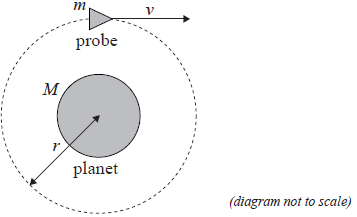Question
A moon \(\mathrm{M}\) orbits a planet \(\mathrm{P}\). The gravitational field strength at the surface of \(\mathrm{P}\) due to \(\mathrm{P}\) is \(g_{\mathrm{P}}\). The gravitational field strength at the surface of \(M\) due to \(M\) is \(g_M\).
For \(\mathrm{M}\) and \(\mathrm{P}\) :
$
\frac{\text { radius of } M}{\text { radius of } P}=0.27 \text { and } \frac{\text { mass of } M}{\text { mass of } P}=0.055
$
(a) Determine \(\frac{g_M}{g_p}\).
(b) Point O lies on the line joining the centre of M to the centre of P.

The graph shows the variation of gravitational potential V with distance x from the
surface of P to O.
The gradient of the graph is zero at point O.
(i) State and explain the magnitude of the resultant gravitational field strength at \(\mathrm{O}\).[2]
(ii) Outline why the graph between \(\mathrm{P}\) and \(\mathrm{O}\) is negative.[2]
(iii) Show that the gravitational potential \(V_P\) at the surface of \(P\) due to the mass of \(P\) is given by \(V_{\mathrm{p}}=-g_{\mathrm{p}} R_{\mathrm{p}}\) where \(R_{\mathrm{p}}\) is the radius of the planet.[2]
(iv) The gravitational potential due to the mass of \(\mathrm{M}\) at the surface of \(\mathrm{P}\) can be assumed to be negligible.
Estimate, using the graph, the gravitational potential at the surface of \(\mathrm{M}\) due to the mass of \(\mathrm{M}\). [2]
(v) Draw on the axes the variation of gravitational potential between O and M. [1]
▶️Answer/Explanation
Ans:
Work using \(g \propto \frac{m}{r^2} \checkmark\)
$
\frac{g_M}{g_p}=\frac{m_M}{m_p}\left(\frac{r_p}{r_M}\right)^2=0.75
$
b i $
g=0
$
As \(g \&=-\frac{\Delta V_g}{\Delta r}\) which \(»\) is the gradient of the graph
OR
As the force of attraction/field strength of \(\mathrm{P}\) and \(\mathrm{M}\) are equal
b ii The gravitational field is attractive so that energy is required «to move away from \(P_n \checkmark\) the gravitational potential is defined as 0 at \(\infty\), (the potential must be negative) \(\checkmark\)
iii \(V_{\mathrm{P}}=-\frac{G M}{R_{\mathrm{p}}}\) AND \(g_{\mathrm{P}}=\frac{G M}{R_{\mathrm{p}}^2}\) (at surface)
Suitable working and cancellation of \(G\) and \(M\) seen \(\checkmark\) \(V_p=-g_p R_p\)
iv \(\begin{aligned} & \alpha \frac{V_M}{V_p}=\frac{g_M R_M}{g_p R_p}=0.75 \times 0.27 w=0.20^{\checkmark} \\ & V_M=\alpha-6.4 \times 10^7 \times 0.2=» \approx-» 1.3 \times 10^7 \ll \mathrm{J} \mathrm{kg}^{-1} \rightsquigarrow \\ & \end{aligned}\)
v.Line always negative, of suitable shape and end point below -8 and above -20 unless awarding \(E C F\) from \(b\) (iv)

This question is about a probe in orbit.
A probe of mass m is in a circular orbit of radius r around a spherical planet of mass M.

a.
State why the work done by the gravitational force during one full revolution of the probe is zero.
Deduce for the probe in orbit that its
(i) speed is \(v = \sqrt {\frac{{GM}}{r}} \).
(ii) total energy is \(E = – \frac{{GMm}}{{2r}}\).
It is now required to place the probe in another circular orbit further away from the planet. To do this, the probe’s engines will be fired for a very short time.
State and explain whether the work done on the probe by the engines is positive, negative or zero.
Answer/Explanation
Markscheme
a.
because the force is always at right angles to the velocity / motion/orbit is an equipotential surface;
Do not accept answers based on the displacement being zero for a full revolution.
(i) equating gravitational force \(\frac{{GMm}}{{{r^2}}}\);
to centripetal force \(\frac{{m{v^2}}}{r}\) to get result;
(ii) kinetic energy is \(\frac{{GMm}}{{2r}}\);
addition to potential energy −\(\frac{{GMm}}{{r}}\) to get result;
the total energy (at the new orbit) will be greater than before/is less negative;
hence probe engines must be fired to produce force in the direction of motion / positive work must be done (on the probe);
Award [1] for mention of only potential energy increasing.